
Natural Science - Year I
Unit 4: Early Babylon and Egypt - Naked Eye Astronomy

Science Web Assignment for Unit 4
| This Unit's | Homework Page | History Lecture | Science Lecture | Lab | Parents' Notes |
Science Lecture for Unit 4: Naked-Eye Astronomical Observations
For Class
- Topic area: Astronomy: Naked eye observations
- Terms and concepts to know: Planets, stars constellations, coordinate systems, ecliptic, celestial equator, eclipse, lunar phases
- See historical period(s): Babylon and Egypt
Outline/Summary
Naked Eye Astronomy
The ancient cultures in Mesopotamia and Egypt amassed a great deal of data about the objects in the sky, both terrestrial and celestial. In particular, they noticed that several types of objects had periodic motions or cyclical appearances. Our goal this time is to understand what they knew (and what we can still observe without special instruments about)
- climate patterns (sunlight and daytime lengths)
- seasons
- the daily motions of the Sun, Moon, planets, and stars due to the Earth's rotation on its axis
- the north-south motions of the Sun, Moon, and planets due to the Earth's tilt on its axis
- the phases of the Moon due to its motion around the Earth; eclipses of the Sun and Moon
- the motions of the planets
- the annual motion of the Sun and stars
The Earth and the Sun
The primary motion of the Sun in the sky is its daily motion from east to west. This motion is the result of the Earth's rotation on its axis. The Earth spins, and the Sun appears to move in the opposite direction across the sky.
The Earth also revolves or orbits around the Sun in an ellipse that is very nearly a circle. The axis of the Earth's spin is tilted to the plane of the Earth's orbit--a fact that has an enormous impact on Earth's climate. We've already defined climate as the general long term pattern or condition of sunlight, rainfall, and temperatures for a given area. Let's look at sunlight, the source of all the energy that drives weather and life processes on our planet.
The amount of sunlight that falls on a given area of the Earth (assuming the sky is clear) depends on the height of the Sun in the sky:
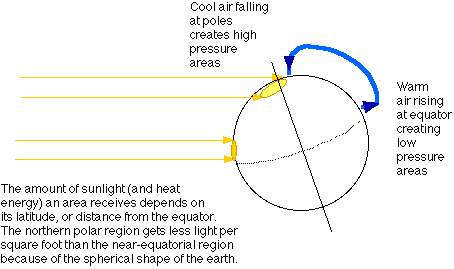
Because the sunlight reaching the Earth at the poles is spread out over much greater area than the sunlight reaching the Earth at the equator, there is much less energy available for the same area at the poles. Even with 24-hour sunlight during the summer, there is not enough light at the poles to heat up the ice caps and foster plant growth.
The rising and falling air in the diagram above also moves sideways, a result of the uneven heating and cooling that occurs when air passes over ocean and then land. The movements of air masses, as we have seen, give rise to daily weather; patterns of movements and the precipitation they carry give rise to persistent patterns that make up an area's climate.
There are only a few types of climate in the world: polar, desert, temperate, tropical, and near-ocean. Hours of sunlight per day determines the amount of energy available for living things, particularly plants, to absorb and grow. Rainfall provides liquid water, which is necessary for all life. Extremes of temperature limit the types of plants and animals that can survive in the areas controlled by the climate.
While some animals can control certain aspects of their environment despite the climate (beavers, for example, can create dams that store water for rainfall shortages), man is the only animal that can change the environment enough to survive in a region despite the climate. Consequently, climate conditions are also life conditions.
Climates are not static. Modern geology interprets certain rock deposits and formations as indicating that severely cold periods—ice ages lasting thousands of years—repeatedly gripped the North American continent, with the last receding only 11 000 years ago. More recent historical records of agricultural activity in Europe indicate that a general cold spell gripped that continent in the fifteenth and sixteenth century, destroying wine production in England. In our own century, accurate records of the last 30-70 years show a slight but steady increase in temperature over the entire globe, something many people find alarming, especially since climates control our ability to produce food for ourselves.
Back to astronomy: motions
There are four types of permanent objects that we can see easily without a telescope: the Sun, the Moon, the planets (Mercury, Venus, Mars, Jupiter, and Saturn), and the brighter stars, about 3000 of them easily visible in clear weather. Each of these appears to move about in the sky. Figuring out how the objects actually move is complicated because the Earth itself has two movements, one the daily rotation on its axis and the other its annual revolution around the Sun. (There are other movements, like the slight wobble called nutation that causes the north celestial pole to move slowly away from Polaris, but we won't worry about that here). An observer on Earth sees the motion of the Sun, Moon, planets, and stars from a moving platform.
The Sun's daily motion
Each day we see the Sun, Moon, planets, and stars rise in the east and set in the west. While we realize now that this daily motion is the result of the Earth's rotation on its axis, for the purposes of simplicity in plotting positions in the sky, we still talk as though the Sun moves east and the planets occasionally go backwards.
The simplest motions are those of the Sun and the background stars. While these both rise and set daily, they don't keep exactly the same pace. Let's see why there is a difference between a solar day and a sidereal (star) day, where a day is the time between two appearances of the star or Sun directly overhead.
At noon one day, both the Sun and a very distant star are directly overhead. As the Earth turns on its axis counterclockwise (as seen from above the north pole), it also revolves around the Sun in a counterclockwise circle. The Earth makes one complete turn on its axis. The very distant star is overhead again, but the Sun isn't overhead again! Because the Earth has moved a bit around the Sun, it has to turn a little more to get the Sun directly overhead. The time to reach solar noon is 4 minutes more than the time it takes to reach stellar noon (see the diagram below).
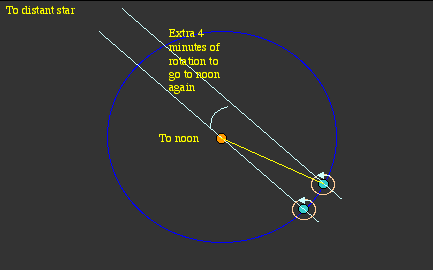
So a sidereal day is 23 hours, 56 minutes long, while a solar day is 24 hours long.
The Sun's annual motion
Because of the Earth's annual revolution around the Sun, the Sun appears to move eastward or left each day from its previous position, as seen against the background stars. Stars that were "behind" the Sun move out into visibility to the right or west of the Sun, becoming morning stars (rising before the Sun does into a dark sky). The first time they appear in the morning before the Sun after being lost for several months in the Sun's glare is called the heliacal rising of the star (rising after Helos, the Sun).
Over the course of the year, the Sun appears to move once all the way around the sky. The constellations through which it appears to pass were important markers in the sky to the ancient observers; there are twelve of them and because many of them are animals, they were called the Zodiac constellations (from the Greek zoe, life).
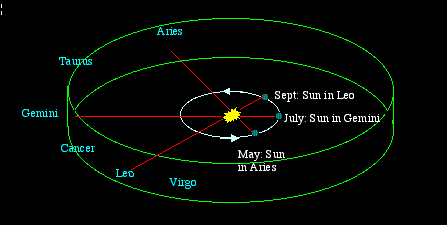
The path of the Sun through the middle of the Zodiac band is called the ecliptic.
The animation below from the Dorthonion Astronomy site may help you visualize how the Sun's appearance against the background sky, and the constellations visible at night, depend on the Earth's position relative to the Sun.
The Moon's monthly motions
Let's now look at the Moon, which goes around the Earth once every 29 days or so. Like the Sun, the Moon has both a synodic month , which we count from full Moon to full Moon, and a sidereal month, from position in the sky back to the same position in the sky relative to a distant star. Just like the Sun, the Moon's apparent position is affected by the Earth's motion, and the sidereal month is shorter than the synodic month.
The Moon's orbit lies in a plane that is tilted just a little from the plane of the Sun's "orbit". Think of the plane of Sun's "orbit" (really the position of the Sun as the Earth moves) as a plate, with the Earth at the center (a small apple) and the Sun on the edge (a large grapefruit) . From the apple's (Earth's) point of view, the Sun moves around the edge of the plate once each year. Now put the Moon (a smaller apple) on the plate. It moves around the Earth once a month, sometimes between the Earth and the Sun, sometimes on the other side of the Earth from the Sun. But the plane of the Moon's orbit isn't quite on the plate of the Sun's orbit; sometimes the Moon is above the plate, and sometimes it is below. The two points at which the Moon's orbit crosses the plane of the Sun's orbit are called nodes.
When the Moon is between the Earth and the Sun, the Sun shines on the far side, and we can't see the Moon easily. We call this phase "new Moon". As the Moon moves (counterclockwise if you are looking down on the Earth from above the north pole), a part of the lit-up side becomes visible, and we see the Moon as a crescent in the evening sky, to the east (left) of the Sun when you are looking southwest at sunset.
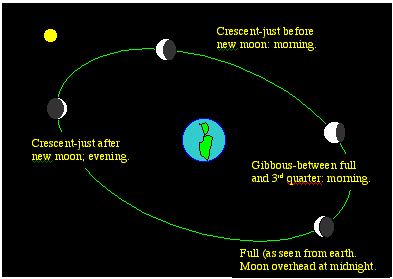
Each night the Moon moves eastward, rises about 51 minutes later, and a little more of its lit-up face becomes visible from Earth. Eventually it rises at sunset, on the opposite side of the Earth from the Sun. This is the "full Moon". After this point, the lit-up side of the Moon shrinks, and it rises after midnight. If you get up early, you can see this third-quarter Moon in the morning just before (and sometimes after) dawn.
Solar Eclipses
When the Moon is new and at one of its nodes (where the orbit of the Moon crosses the orbit of the Sun), the Moon will lie directly between the Earth and the Sun, and we will have a solar eclipse. The Moon's orbit is also elliptical--a squashed circle, and the Earth is not quite at the center. This means that sometimes the Moon is closer to the Earth than at other times. If the Moon is at its nearest approach to Earth (called perigee, from the Greek for "near" (per), and "Earth" (Geos)), it will appear larger and during a solar eclipse will cover the whole face of the Sun. When the Moon is at its farthest point from Earth (apogee), it is too small to cover the whole surface of the Sun during an eclipse, and a ring of the Sun's surface will still show around the Moon. This is called an annular eclipse.
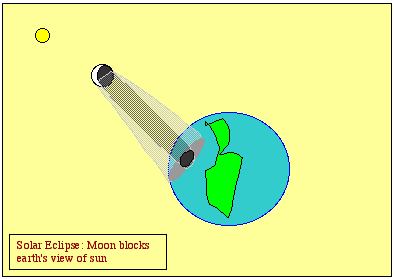
Because the Moon is moving so quickly in the sky, it crosses the surface of the Sun in just a few hours. From the start to the end of an eclipse takes at most 3 hours, and the longest time the Moon can cover the Sun entirely (as seen from by an Earth observer) is about 7 minutes. During this time, however, properly-equipped observers can look at the Corona of the Sun--the outer atmosphere that is usually lost in the brighter light from the Sun's surface. The shadow cast by the Moon on the Earth is small, and only people directly in the path of that shadow will see the total eclipse. People near the edges will see the Moon cover only part of the Sun. To everyone else, the Sun will appear normal.
Solar eclipses do not occur every new Moon because the Moon is usually above or below the Sun's orbit. When they do occur, both professional and amateur astronomers may travel halfway across the world to view and record the eclipse and study the Sun's corona and other phenomena visible only during these events. The last total solar eclipse in the US was in 2017.
Lunar eclipse
When the Moon is on the far side of the Earth from the Sun (full Moon) and near a node, it passes through the Earth's shadow. While it doesn't disappear entirely, its surface becomes red and then dark. Because the Earth's shadow is much larger than the Moon's, lunar eclipses occur more frequently than solar eclipses. Also, because the Earth itself is casting the shadow, everyone on the night side of the Earth will see the lunar eclipse.
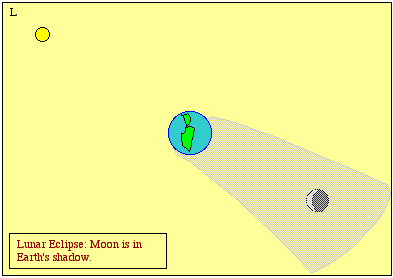
We had a lunar eclipse this July, which will occur just before dawn for most of the US.
Tides
As the Moon moves around the Earth, it attracts the planet as much as the planet attracts it. The oceans are free to move and change shape in response to this attraction, so a "bulge" of water follows the Moon around every day as the Earth turns. This bulge creates high tide--one on the near side and one on the far side of the Earth from the Moon; at the points in between, the tides are low. When the Sun and Moon along the same line, near new Moon and full Moon, tides are high. When the Sun and Moon pull at right angles to each other, near first and third quarter, the tides are lower.
The motion of the tides drag on the Earth's rotational motion, slowing it down very slightly over time. If we extrapolate this slowdown backwards in time long enough, say a billion years, then the Earth's day could have been much shorter--20 hours, perhaps, instead of 24. This model raises interesting questions for the evolution of plants and animals with diurnal (daily) rhythms.
A second consequence of this slowdown is an increase in the distance between the Earth and the Moon. The two are locked together by their gravitational fields into a single system of shared angular momentum. Angular momentum is the tendency to keep spinning once you start (assuming that you don't need to worry about friction) and for your rate of spin to depend on your radius. If you've every watched an ice skater spin, you've seen the skater twirl much faster simply by raising her arms to decrease her radius, and then slow down by lowering her arms. The Earth and Moon are in a similar situation. As the tidal bulges slow the Earth down, they also drag on the Moon. The Moon slows down--but in order to keep the same angular momentum, it has to move further from Earth.
In summary then
The Sun The Sun has two types of apparent periodic motion which greatly affect the way we live. Its daily motion of rising and setting defines the day, a period which, like the Babylonians, we divide into 24 hours of 60 minutes each. In its annual motion, the Sun returns to the same position against the background sky every 365.254 (or so) days. Both of these motions are in fact the result of Earth's daily motion (rotation) and annual motion (revolution around the Sun).
The Moon The Moon also has a daily motion, rising and setting, but it also has a motion due to its revolution around Earth, rising about 51 minutes later each day compared to the rising of the Sun. Over the course of about 29 days, the Moon appears to go completely around the Earth, returning to its original position against the background of the stars in 27.3 days, and its position relative to the Sun (which has also been moving against the background of the stars) in 29.53 days.
The Planets Before the invention of the telescope, only Mercury, Venus, Mars, Jupiter, and Saturn were observable. Their paths across the sky are complex backwards and forwards loops, which we realize now are the result of the combination of their motion and Earth's around the Sun. But there was no way to observe Earth's actual motion before the 19th century; the ancients had to explain the loop-de-loops of the planets starting with the idea that the Earth was standing still in the center of the heavens.
The Stars Men could see the daily motion of the stars along with the daily motion of the Sun, all moving in the same direction (westward). But while the Sun , Moon, and planets all moved against the background sky, the stars did not appear to move at relative to each other. It s as though they were the same distance away, all affixed to some giant sphere rotating on an axis--a model that is still used in every planetarium in the world for teaching observational astronomy.
Study/Discussion Questions
- What daily motions of celestial objects can we see without a telescope?
- What annual motions of celestial objects can we see without a telescope?
- Why does the Moon have different phases (appear differently over the course of a month)?
- What is an eclipse? Why do eclipses occur in a set pattern?
Further Study On your Own (Optional)
- Nick Strobel has published a very thorough discussion of many aspects of naked-eye astronomy at the Astronomy Notes site.
© 2005 - 2024 This course is offered through Scholars Online, a non-profit organization supporting classical Christian education through online courses. Permission to copy course content (lessons and labs) for personal study is granted to students currently or formerly enrolled in the course through Scholars Online. Reproduction for any other purpose, without the express written consent of the author, is prohibited.